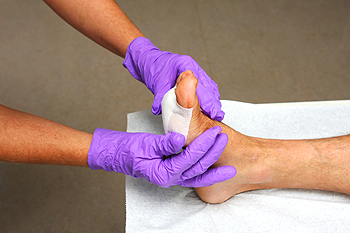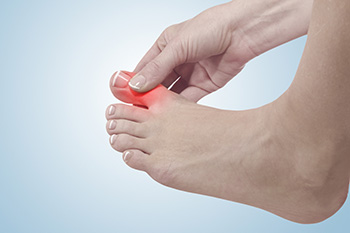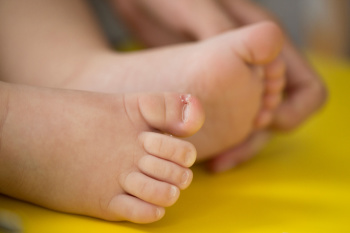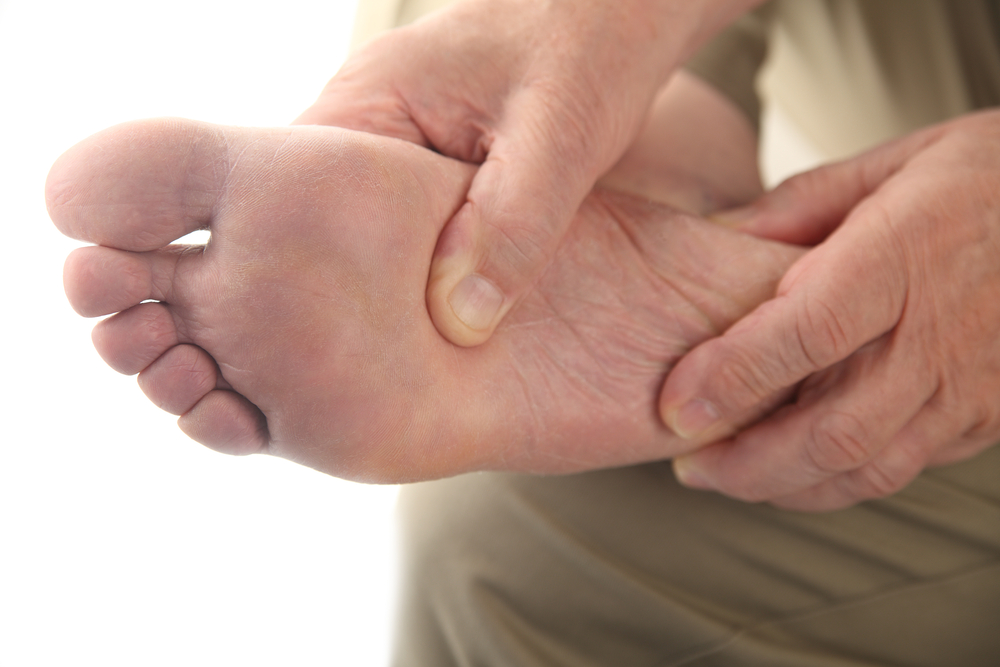September 2024
Effective Steps to Heal a Foot Wound

Healing a minor foot wound involves several important steps and visiting a podiatrist to ensure proper care and recovery. This doctor begins by gently cleaning the wound with mild soap and water to remove dirt and debris, then pats the area dry with a clean towel to avoid further irritation. He or she will guide you to use an antibiotic cream on the wound to prevent infection and promote healing. Next, the wound is covered with a sterile bandage or dressing, ensuring it fits snugly but comfortably to protect the area from dirt and bacteria. The podiatrist will explain how to change the bandage if it becomes wet or dirty, in addition to monitoring the wound for signs of infection such as increased redness, swelling, or pus. If you have a foot wound, it is strongly suggested that you are under the care of a podiatrist who can treat it effectively and safely.
Wound care is an important part in dealing with diabetes. If you have diabetes and a foot wound or would like more information about wound care for diabetics, consult with one of our podiatrists from Family Foot Care. Our doctors will assess your condition and provide you with quality foot and ankle treatment.
What Is Wound Care?
Wound care is the practice of taking proper care of a wound. This can range from the smallest to the largest of wounds. While everyone can benefit from proper wound care, it is much more important for diabetics. Diabetics often suffer from poor blood circulation which causes wounds to heal much slower than they would in a non-diabetic.
What Is the Importance of Wound Care?
While it may not seem apparent with small ulcers on the foot, for diabetics, any size ulcer can become infected. Diabetics often also suffer from neuropathy, or nerve loss. This means they might not even feel when they have an ulcer on their foot. If the wound becomes severely infected, amputation may be necessary. Therefore, it is of the upmost importance to properly care for any and all foot wounds.
How to Care for Wounds
The best way to care for foot wounds is to prevent them. For diabetics, this means daily inspections of the feet for any signs of abnormalities or ulcers. It is also recommended to see a podiatrist several times a year for a foot inspection. If you do have an ulcer, run the wound under water to clear dirt from the wound; then apply antibiotic ointment to the wound and cover with a bandage. Bandages should be changed daily and keeping pressure off the wound is smart. It is advised to see a podiatrist, who can keep an eye on it.
If you have any questions, please feel free to contact our offices located in Valatie and Albany, NY . We offer the newest diagnostic and treatment technologies for all your foot care needs.
What Are the Causes of Big Toe Pain?

Big toe pain can be both uncomfortable and disruptive, often stemming from various underlying causes. One common culprit is gout, a form of arthritis caused by a buildup of uric acid crystals in the joint, leading to sudden, severe pain and swelling. Another potential cause is bunions, which occur when the big toe deviates towards the other toes, causing pain and pressure. Other issues include sesamoiditis, inflammation of the small bones under the big toe, and trauma or injury to the toe joint. Complications from untreated big toe pain include difficulties with walking and changes in gait, which may strain other joints and muscles. Accurate diagnosis and appropriate treatment are important to address these issues effectively. If you are experiencing persistent or severe pain in your big toe, it is suggested you make an appointment with a podiatrist for a thorough evaluation and tailored treatment plan.
Toe pain can disrupt your daily activities. If you have any concerns, contact one of our podiatrists of Family Foot Care. Our doctors can provide the care you need to keep you pain-free and on your feet.
What Causes Toe Pain?
Most severe toe pain is caused due to a sports injury, trauma from dropping something heavy on the toe, or bumping into something rigid. Other problems can develop over time for various reasons.
Toe pain can be caused by one or more ailments. The most common include:
- Trauma
- Sports injury
- Wearing shoes that are too tight
- Arthritis
- Gout
- Corns and calluses
- Hammertoe
- Bunions
- Blisters
- Ingrown toenails
- Sprains
- Fractures (broken bones)
- Dislocations
When to See a Podiatrist
- Severe pain
- Persistent pain that lasts more than a week
- Signs of infection
- Continued swelling
- Pain that prevents walking
Diagnosis
In many cases the cause of toe pain is obvious, but in others, a podiatrist may want to use more advanced methods to determine the problem. These can range from simple visual inspections and sensation tests to X-rays and MRI scans. Prior medical history, family medical history, and any recent physical traumatic events will all be taken into consideration for a proper diagnosis.
Treatment
Treatments for toe pain and injuries vary and may include shoe inserts, padding, taping, medicines, injections, and in some cases, surgery. If you believe that you have broken a toe, please see a podiatrist as soon as possible.
If you have any questions please feel free to contact our offices located in Valatie and Albany, NY . We offer the newest diagnostic tools and technology to treat your foot and ankle needs.
Arthritis Can Cause Pain in the Feet and Ankles
Ingrown Toenails 101

An ingrown toenail occurs when the edge of a toenail grows into the surrounding skin, leading to pain, redness, and swelling. It commonly affects the big toe and can be caused by improper nail trimming, tight footwear, or genetic predisposition. Symptoms include sharp, throbbing pain, increased sensitivity, and, in more severe cases, infection with pus or drainage. Initial treatments for an ingrown toenail involve soaking the foot in warm, soapy water to reduce inflammation and pain. Mild pain relievers and antibiotic ointments can manage discomfort and prevent infection. Avoid cutting the nail yourself as improper trimming can worsen the condition. If symptoms persist or worsen, professional treatment from a podiatrist may be necessary. For a comprehensive evaluation and effective management of an ingrown toenail, it's suggested you make an appointment with a podiatrist.
Ingrown toenails may initially present themselves as a minor discomfort, but they may progress into an infection in the skin without proper treatment. For more information about ingrown toenails, contact one of our podiatrists of Family Foot Care. Our doctors can provide the care you need to keep you pain-free and on your feet.
Ingrown Toenails
Ingrown toenails are caused when the corner or side of a toenail grows into the soft flesh surrounding it. They often result in redness, swelling, pain, and in some cases, infection. This condition typically affects the big toe and may recur if it is not treated properly.
Causes
- Improper toenail trimming
- Genetics
- Improper shoe fitting
- Injury from pedicures or nail picking
- Abnormal gait
- Poor hygiene
You are more likely to develop an ingrown toenail if you are obese, have diabetes, arthritis, or have any fungal infection in your nails. Additionally, people who have foot or toe deformities are at a higher risk of developing an ingrown toenail.
Symptoms
Some symptoms of ingrown toenails are redness, swelling, and pain. In rare cases, there may be a yellowish drainage coming from the nail.
Treatment
Ignoring an ingrown toenail can have serious complications. Infections of the nail border can progress to a deeper soft-tissue infection, which can then turn into a bone infection. You should always speak with your podiatrist if you suspect you have an ingrown toenail, especially if you have diabetes or poor circulation.
If you have any questions, please feel free to contact our offices located in Valatie and Albany, NY . We offer the newest diagnostic and treatment technologies for all your foot care needs.
Diabetic Foot Problems

Diabetic foot problems are a complication, arising from poor blood circulation and nerve damage. These issues can lead to symptoms such as numbness, pain, and foot ulcers. If left untreated foot ulcers may result in severe infections or even amputation. Proper foot care is key in managing these risks. Daily inspections for cuts, blisters, or other abnormalities are important, alongside keeping feet clean and moisturized. Wearing well-fitting shoes can prevent unnecessary pressure and injuries. Treatment often involves managing blood sugar levels, using prescribed antibiotics for infections, and employing specialized wound care techniques. In severe cases, surgical intervention might be necessary. Regular visits to a podiatrist can help in early detection and prevention of diabetic foot complications, ensuring that your feet stay healthy and comfortable. If you have diabetes, it’s suggested you make an appointment with a podiatrist to keep your feet in the best possible condition.
Diabetic foot care is important in preventing foot ailments such as ulcers. If you are suffering from diabetes or have any other concerns about your feet, contact one of our podiatrists from Family Foot Care. Our doctors can provide the care you need to keep you pain-free and on your feet.
Diabetic Foot Care
Diabetes affects millions of people every year. The condition can damage blood vessels in many parts of the body, especially the feet. Because of this, taking care of your feet is essential if you have diabetes, and having a podiatrist help monitor your foot health is highly recommended.
The Importance of Caring for Your Feet
- Routinely inspect your feet for bruises or sores.
- Wear socks that fit your feet comfortably.
- Wear comfortable shoes that provide adequate support.
Patients with diabetes should have their doctor monitor their blood levels, as blood sugar levels play such a huge role in diabetic care. Monitoring these levels on a regular basis is highly advised.
It is always best to inform your healthcare professional of any concerns you may have regarding your feet, especially for diabetic patients. Early treatment and routine foot examinations are keys to maintaining proper health, especially because severe complications can arise if proper treatment is not applied.
If you have any questions please feel free to contact our offices located in Valatie and Albany, NY . We offer the newest diagnostic and treatment technologies for all your foot and ankle needs.




